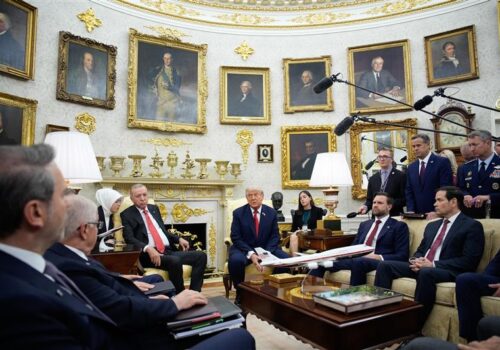Last month, Turkey and the United Kingdom formalized a landmark defense deal, a move that carries significant geopolitical implications beyond its military outcomes. Ankara committed to purchase twenty new Eurofighter Typhoon combat aircraft from London. The procurement is valued at $10.7 billion and marks the first new export order for the baseline since 2017.
The deal underscores both London’s aggressive push to break into the lucrative Turkish weapons market and Ankara’s urgent need to modernize its air warfare deterrent as its efforts to secure F-16V modernization and return to the F-35 Joint Strike Fighters program have stalled. The procurement could lead to deeper intra-NATO defense-industrial cooperation between two non-European Union nations located on Europe’s western and eastern flanks.
Turkey’s air warfare choice: A non-stealth fighter that can still matter in contested airspace
The Eurofighter Typhoon is one of Europe’s three principal combat aircraft options alongside the French Dassault Rafale and Sweden’s Saab Gripen. US dominance in the continent’s weapons markets is becoming more pronounced, as evidenced by the F-35’s consecutive wins in European tactical combat aircraft tenders. Nevertheless, the Eurofighter forms the backbone of various countries’ airwings, where it operates as a bridge between legacy capabilities and future air warfare concepts. Telltale indicators suggest that the baseline will keep flying until the 2060s, though some nations will likely phase it out sooner. The four-nation program, involving the British, German, Italian, and Spanish defense industries, also supports the production of military aerial engines in Europe.
To provide the Turkish Air Force with the Eurofighter Typhoons, Britain’s BAE Systems will lead major airframe manufacturing and weapons integration, primarily in Lancashire and other production pipelines. The British government estimates that the deal will create twenty thousand new jobs throughout the United Kingdom. The Turkish order will likely involve a comprehensive weapons systems package, including Meteor beyond-visual-range air-to-air missiles and Brimstone air-ground munitions. Unlike the AMRAAM missile’s solid-propellant power pack, the Meteor, with a range of some 124 miles, uses a rocket-ramjet combination that enables it to endure longer flight paths. As a major munitions producer in NATO, ranging from aero-ballistic missiles to cruise missiles and beyond-visual-range air-to-air missiles, Turkey will likely ask the Eurofighter Typhoon’s European consortium to certify its indigenous weapons systems to the Turkish Air Force’s forthcoming tactical airwing. Doing so will offer Ankara more freedom of movement in operational planning without being desperately reliant on the Eurofighter Typhoon’s European weapon systems configurations. As the war in Ukraine has demonstrated, a strong national munitions portfolio is essential when fighting prolonged showdowns via high-tempo combat operations.
From Britain to the Gulf: Scaling the Typhoon fleet to meet Turkish air-warfare demand
The British aircraft will be new, hailing from the latest Tranche-4 variant of the Eurofighter Typhoon baseline. However, the delivery timeline will extend to 2030. Turkey needs the Eurofighter Typhoons as a stopgap capability between its aging F-16 fleet and its forthcoming, fifth-generation airpower asset, KAAN. Recognizing this five-year gap, the Turkish government is eying Gulf Arab Eurofighter arsenals. Turkish defense outlets suggest that Ankara is looking to procure a twelve-platform Eurofighter Typhoon package from the Qatari Tranche-3A AESA radar-equipped pool. Oman’s small Typhoon arsenal could also be a modest source for the Turkish Air Force, though Turkey has closer ties to Qatar and more diplomatic capital in Doha than it does in Muscat. Buying immediately from Qatar or Oman would allow Turkey to develop its pilot pool’s and ground crews’ understandings of the Eurofighter Typhoon and achieve operational capability within a few years. Such a move would make the Turkish Air Force a Eurofighter-flying branch before the British Tranche-4 deliveries kick in. At this juncture, it is important to monitor if Ankara will pursue a parallel track to finalize F-16V modernization amid price disputes and negotiations with the US defense giant Lockheed Martin. Given the United States’ decades-long dominance in the Turkish tactical aircraft market, this dispute with Lockheed Martin, at a time when Turkish and European defense cooperation is expanding, could lead to further defense trade reshuffles.
A fourth-generation answer to a fifth-generation problem
Strategically, Turkey’s Eurofighter deal with Britain is far more than an off-the-shelf purchase. It anchors deeper Turkish-British defense ties and preserves a key European production line. For Ankara, the deal modernizes its fleet, improves allied interoperability, and positions Turkey in a stronger air warfare posture within NATO. The Eurofighter can also provide the industrial bridge that Turkey needs while facing shortfalls in fifth-generation capabilities caused by its exclusion from the United States’ F-35 program and the lengthy development runway of its indigenous KAAN multirole platform. If realized, shared maintenance, logistics, avionics, and weapons integration for the Eurofighter Typhoon can even lay some groundwork to help KAAN’s co-development, allowing Turkey to evolve from being merely a buyer to a defense partner, although there is little, if any, chance that Ankara will join the European consortium behind the Eurofighter baseline.
Turkey’s Eurofighter Typhoon procurement delivers an immediate NATO-standard boost to its airpower, offering credible air superiority and standoff strike capacity across the nation’s troubled neighborhood, which has been shaped by wars. High-end weapons, such as the Meteor and the Brimstone, will enhance the Turkish aerial deterrent’s firepower, while the Eurofighter’s agility, twin-engine reliability, and modern sensors will offer more advantages.
Still, the Eurofighter Typhoon is not the F-35. The combat aircraft lacks low observability. Thus, combat-deploying the Eurofighters in heavily defended airspace would require very careful planning, intensive electronic warfare support, and coalition enablers. It is not the legacy F-16, either: keeping highly combat-ready Eurofighter Typhoon squadrons will require allocating more resources and money. They are more demanding and expensive beasts to operate. Moreover, flying a dual tactical airwing, consisting of the F-16s and the Eurofighter Typhoons, would inevitably lead to swollen defense expenditures for Ankara and Turkish taxpayers: it will be sustainable but surely costlier.
Nonetheless, amid political fluctuations, this diversification of suppliers is an insurance policy for Turkey in a world that has been losing its once-predictable diplomatic patterns. The Eurofighter Typhoon deal does not mean that the Turkish Air Force would no longer need the F-16V modernization, nor would it end the nation’s quest for achieving the fifth-generation tactical combat aircraft capability. In practical terms, the twenty-piece Eurofighter Typhoon package for the Turkish Air Force, one of the largest operators of the F-16s around the globe, is like a good protein bar for an Olympic athlete. It would not compensate for a full meal, but would still offer a feasible, interim solution under time pressure.
Can Kasapoğlu is a senior fellow at the Hudson Institute and a co-editor of the Atlantic Council Turkey Program’s Defense Journal.
The views expressed in TURKEYSource are solely those of the authors and do not necessarily reflect the views of the Atlantic Council, its staff, or its supporters.
Further reading
Thu, Oct 9, 2025
How energy and trade are redefining US–Turkey regional cooperation
TURKEYSource By Pınar Dost
As Ankara and Washington are recalibrating their energy and trade strategies, a new model of US–Turkey cooperation is emerging.
Wed, Sep 10, 2025
To counter Chinese and Russian influence in Africa, Turkey could be a decisive ally for the US and Europe
AfricaSource By Rama Yade, Defne Arslan
As Turkey continues to develop closer ties to African nations, the United States and Europe should work with Turkey as a partner in its efforts to gain soft power throughout the continent.
Fri, Feb 21, 2025
In strengthening its security architecture, Europe shouldn’t discount Türkiye’s role
TURKEYSource By
Europe needs to look outside of its current framework for security solutions. Türkiye can play a role.
Image: British Prime Minister Keir Starmer and Defence Secretary John Healey speak with British armed forces personnel in front of a UK Typhoon fighter jet at Tusas airbase in Ankara, during a visit to Turkey, October 27, 2025. Stefan Rousseau/Pool via REUTERS.




